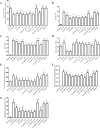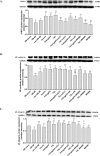Tongxinluo attenuates reperfusion injury in diabetic hearts by angiopoietin-like 4-mediated protection of endothelial barrier integrity via PPAR-α pathway
- PMID: 29912977
- PMCID: PMC6005559
- DOI: 10.1371/journal.pone.0198403
Tongxinluo attenuates reperfusion injury in diabetic hearts by angiopoietin-like 4-mediated protection of endothelial barrier integrity via PPAR-α pathway
Abstract
Objective: Endothelial barrier function in the onset and Tongxinluo (TXL) protection of myocardial ischemia/reperfusion (I/R) injury, and TXL can induce the secretion of Angiopoietin-like 4 (Angptl4) in human cardiac microvascular endothelial cells during hypoxia/reoxygenation. We intend to demonstrate whether TXL can attenuate myocardial I/R injury in diabetes, characterized with microvascular endothelial barrier disruption, by induction of Angptl4-mediated protection of endothelial barrier integrity.
Methods and results: I/R injury was created by coronary ligation in ZDF diabetic and non-diabetic control rats. The animals were anesthetized and randomized to sham operation or I/R injury with or without the exposure to insulin, rhAngptl4, TXL, Angptl4 siRNA, and the PPAR-α inhibitor MK886. Tongxinluo, insulin and rhAngptl4 have the similar protective effect on diabetic hearts against I/R injury. In I/R-injured diabetic hearts, TXL treatment remarkably reduced the infarct size, and protected endothelial barrier integrity demonstrated by decreased endothelial cells apoptosis, microvascular permeability, and myocardial hemorrhage, fortified tight junction, and upregulated expression of JAM-A, integrin-α5, and VE-cadherin, and these effects of TXL were as effective as insulin and rhAngptl4. However, Angptl4 knock-down with siRNA interference and inhibition of PPAR-α with MK886 partially diminished these beneficial effects of TXL and rhAngptl4. TXL induced the expression of Angptl4 in I/R-injured diabetic hearts, and was canceled by Angptl4 siRNA and MK886. TXL treatment increased myocardial PPAR-α activity, and was abolished by MK886 but not by Angptl4 siRNA.
Conclusions: TXL protects diabetic hearts against I/R injury by activating Angptl4-mediated restoration of endothelial barrier integrity via the PPAR-α pathway.
Conflict of interest statement
The authors have declared that no competing interests exist.
Figures







Similar articles
-
Tongxinluo attenuates oxygen-glucose-serum deprivation/restoration-induced endothelial barrier breakdown via peroxisome proliferator activated receptor-α/angiopoietin-like 4 pathway in high glucose-incubated human cardiac microvascular endothelial cells.Medicine (Baltimore). 2020 Aug 21;99(34):e21821. doi: 10.1097/MD.0000000000021821. Medicine (Baltimore). 2020. PMID: 32846824 Free PMC article.
-
Preventive effect of Tongxinluo on endothelial survival and vascular integrity, together with inhibition of inflammatory reaction in rats model of intestine ischemia/reperfusion injury.Pak J Pharm Sci. 2018 Nov;31(6):2403-2410. Pak J Pharm Sci. 2018. PMID: 30473511
-
Tongxinluo exerts protective effects via anti-apoptotic and pro-autophagic mechanisms by activating AMPK pathway in infarcted rat hearts.Exp Physiol. 2017 Apr 1;102(4):422-435. doi: 10.1113/EP086192. Epub 2017 Mar 14. Exp Physiol. 2017. PMID: 28150462
-
Angiopoietin-like protein 4: A therapeutic target for triglycerides and coronary disease?J Clin Lipidol. 2018 May-Jun;12(3):583-587. doi: 10.1016/j.jacl.2018.01.012. Epub 2018 Feb 2. J Clin Lipidol. 2018. PMID: 29548670 Review.
-
Role of Angptl4 in vascular permeability and inflammation.Inflamm Res. 2014 Jan;63(1):13-22. doi: 10.1007/s00011-013-0678-0. Epub 2013 Oct 31. Inflamm Res. 2014. PMID: 24173241 Review.
Cited by
-
China Tongxinluo Study for myocardial protection in patients with Acute Myocardial Infarction (CTS-AMI): Rationale and design of a randomized, double-blind, placebo-controlled, multicenter clinical trial.Am Heart J. 2020 Sep;227:47-55. doi: 10.1016/j.ahj.2020.06.011. Epub 2020 Jun 20. Am Heart J. 2020. PMID: 32679281 Free PMC article.
-
Tongxinluo-pretreated mesenchymal stem cells facilitate cardiac repair via exosomal transfer of miR-146a-5p targeting IRAK1/NF-κB p65 pathway.Stem Cell Res Ther. 2022 Jul 7;13(1):289. doi: 10.1186/s13287-022-02969-y. Stem Cell Res Ther. 2022. PMID: 35799283 Free PMC article.
-
PPARα Targeting GDF11 Inhibits Vascular Endothelial Cell Senescence in an Atherosclerosis Model.Oxid Med Cell Longev. 2021 Feb 25;2021:2045259. doi: 10.1155/2021/2045259. eCollection 2021. Oxid Med Cell Longev. 2021. PMID: 33728018 Free PMC article.
-
Microvascular Leakage as Therapeutic Target for Ischemia and Reperfusion Injury.Cells. 2023 May 9;12(10):1345. doi: 10.3390/cells12101345. Cells. 2023. PMID: 37408180 Free PMC article. Review.
-
Skeletal Muscle Angiopoietin-Like Protein 4 and Glucose Metabolism in Older Adults after Exercise and Weight Loss.Metabolites. 2020 Aug 31;10(9):354. doi: 10.3390/metabo10090354. Metabolites. 2020. PMID: 32878157 Free PMC article.
References
-
- Hillis LD, Lange RA (2006) Myocardial infarction and the open-artery hypothesis. N Engl J Med 355: 2475–2477. doi: 10.1056/NEJMe068251 - DOI - PubMed
-
- Zhang L, Liu Y, Lu XT, Wu YL, Zhang C, Ji XP, et al. (2009) Traditional Chinese medication Tongxinluo dose-dependently enhances stability of vulnerable plaques: a comparison with a high-dose simvastatin therapy. Am J Physiol Heart Circ Physiol 297: H2004–2014. doi: 10.1152/ajpheart.00208.2009 - DOI - PubMed
-
- Li XD, Yang YJ, Geng YJ, Jin C, Hu FH, Zhao JL, et al. (2010) Tongxinluo reduces myocardial no-reflow and ischemia-reperfusion injury by stimulating the phosphorylation of eNOS via the PKA pathway. Am J Physiol Heart Circ Physiol 299: H1255–1261. doi: 10.1152/ajpheart.00459.2010 - DOI - PubMed
-
- Cheng YT, Yang YJ, Zhang HT, Qian HY, Zhao JL, Meng XM, et al. (2009) Pretreatment with Tongxinluo protects porcine myocardium from ischaemia/reperfusion injury through a nitric oxide related mechanism. Chin Med J (Engl) 122: 1529–1538. - PubMed
-
- Li XD, Yang YJ, Cheng YT, Dou KF, Tian Y, Meng XM (2013) Protein kinase A-mediated cardioprotection of Tongxinluo relates to the inhibition of myocardial inflammation, apoptosis, and edema in reperfused swine hearts. Chin Med J (Engl) 126: 1469–1479. - PubMed
Publication types
MeSH terms
Substances
Associated data
LinkOut - more resources
Full Text Sources
Other Literature Sources
Medical

